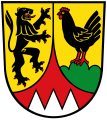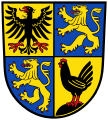House of Henneberg
| Henneberg | |
|---|---|
 | |
| Parent house | Popponids (Babenberg) in turn from the Robertians |
| Titles | Princely Counts of Henneberg |
| Estate(s) | County of Henneberg |
(Princely) County of Henneberg (Gefürstete) Grafschaft Henneberg (de) | |||||||||||||
|---|---|---|---|---|---|---|---|---|---|---|---|---|---|
| c. 1037–1660 | |||||||||||||
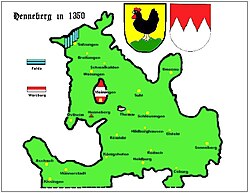 County of Henneberg around 1350 | |||||||||||||
| Status | Principality | ||||||||||||
| Capital | Henneberg Schleusingen Römhild | ||||||||||||
| Common languages | East Franconian | ||||||||||||
| Historical era | Middle Ages, Renaissance | ||||||||||||
• Poppo I, first count | c. 1037 | ||||||||||||
• Internally divided | 1274 | ||||||||||||
• Raised to principality | 1310 | ||||||||||||
| 1500 | |||||||||||||
• Schleusingen branch extinct | 1583 | ||||||||||||
• Divided | 1660 | ||||||||||||
| |||||||||||||
The House of Henneberg was a medieval German comital family (Grafen) which from the 11th century onwards held large territories in the Duchy of Franconia. Their county was raised to a princely county (Gefürstete Grafschaft) in 1310.
Upon the extinction of the line in the late 16th century, most of the territory was inherited by the Saxon House of Wettin and subsequently incorporated into the Thuringian estates of its Ernestine branch.
Origins
The distant origins of this family are speculative yet seem to originate in the Middle Rhine Valley, east of modern-day France. Charibert, a nobleman in Neustria is the earliest recorded ancestor of the family, dating before 636. Five generations pass between Charibert and the next descendant of note, Robert III of Worms. Both the Capetian dynasty and the Popponids (Elder House of Babenberg) are direct male lineal descendants of Count Robert I and therefore referred to as Robertians. Of the Popponids, the Henneberg are most likely to descend from Poppo, Duke of Thuringia.
The designation Babenberger, from the castle of Bamberg (Babenberch), was established in the 12th century by the chronicler Otto of Freising, himself a member of the Babenberg family. The later Younger or Austrian House of Babenberg, which ruled what became the Duchy of Austria, claimed to come of the Elder Babenberg dynasty. However, the descent of the first margrave Leopold I of Austria († 994) from the Elder Babenberger remains uncertain.
County of Henneberg

In the 11th century, the dynasty's estates around the ancestral seat Henneberg Castle near Meiningen belonged to the German stem duchy of Franconia. They were located southwest of the Rennsteig ridge in the Thuringian Forest, then forming the border with the possessions held by the Landgraves of Thuringia in the north. In 1096 one Count Godebold II of Henneberg served as a burgrave of the Würzburg bishops, his father Poppo had been killed in battle in 1078. In 1137 he established Vessra Abbey near Hildburghausen as the family's house monastery.
The counts lost their position as the bishops were raised to "Dukes of Franconia" in the 12th century. Nevertheless, in the course of the War of the Thuringian Succession upon the death of Landgrave Henry Raspe, Count Herman I of Henneberg (1224–1290) in 1247 received the Thuringian lordship of Schmalkalden from the Wettin margrave Henry III of Meissen. After the extinction of the Bavarian House of Andechs upon the death of Duke Otto II of Merania in 1248, the Counts of Henneberg also inherited their Franconian lordship of Coburg (then called the "new lordship", later Saxe-Coburg).
In 1274 the Henneberg estates were divided into the Schleusingen, Aschach-Römhild and Hartenberg branches. Count Berthold VII of Henneberg-Schleusingen (1272–1340) was elevated to princely status in 1310, his estates comprised the towns of Schmalkalden, Suhl and Coburg. In 1343 the Counts of Hennberg also purchased the Thuringian town of Ilmenau. The Coburg lands passed to the Saxon House of Wettin upon the marriage of Countess Catherine of Henneberg to Margrave Frederick III of Meissen in 1347.
After the Imperial Reform of 1500, the County of Henneberg formed the northernmost part of the Franconian Circle, bordering on the Upper Saxon Ernestine duchies and the lands of the Upper Rhenish prince-abbacy of Fulda in the northwest. A thorn in the side remained the enclave of Meiningen, a fief held by the Bishops of Würzburg, which was not acquired by the counts until 1542.
Disestablishment
Whereas the male line of the House of Babenberg became extinct in 1246, the Counts of Henneberg lived on until 1583. In 1554 William IV of Henneberg-Schleusingen had signed a treaty of inheritance with Duke John Frederick II of Saxony. However, when the last Count George Ernest of Henneberg died, both the Ernestine and the Albertine branch of the Wettin dynasty claimed his estates, that were finally divided in 1660 among the Ernestine duchies of Saxe-Weimar and Saxe-Gotha and the Albertine duke Maurice of Saxe-Zeitz. The Lordship of Schmalkalden fell to Landgrave William IV of Hesse-Kassel, according to an inheritance treaty of 1360.
After the Congress of Vienna (1815), the former Albertine parts around Schleusingen and Suhl fell to the Prussian province of Saxony. King Frederick William III of Prussia assumed the title of a Princely Count of Henneberg, which his successors in the House of Hohenzollern have borne ever since.
Counts of Henneberg
Partitions of Henneberg under Henneberg rule
| County of Henneberg (1052–1262) (Gotboldian line from 1091) |
County of Frankenstein (Popponian line) (1091–1354) | ||||||
| County of Irmelshausen then County of Lichtenberg[1] (1144–1255) | |||||||
| County of Botenlauben then County of Hildenburg (1190–1251)[2] |
Burgraviate of Wurzburg (1190–1218) | ||||||
| Sold to the Prince-Bishopric of Würzburg |
|||||||
| County of Coburg (1st creation) (1245–1312) | |||||||
County of Hartenberg (1st creation) (1262–1371) |
County of Aschach (1262–1390) |
County of Schleusingen (1262–1583) |
|||||
| Annexed to Brandenburg- Salzwedel (1312–1353) | |||||||
| Inherited by the Stein zu Nord-Ostheim family | |||||||
| County of Coburg (2nd creation) (1340-1397) | |||||||
| Renamed County of Hartenberg (2nd creation) (1390–1535)[3] |
Annexed to the House of Wettin | ||||||
| County of Römhild (1535–1549) |
County of Schwarza (1535–1577) | ||||||
| Sold to the County of Mansfeld (1549–55) Sold to the Electorate of Saxony (from 1555) |
Annexed to the County of Stolberg | ||||||
| Divided between Hesse-Kassel and Saxony | |||||||
Table of rulers
(Note: There are two manners for numbering the rulers of this noble family: birth numbers or regnal numbers. Albeit the birth number is more commonly used, the table uses the sequential regnal numbers presented in Stammliste von Henneberg, to avoid confusion or holes in the counting. According to this alternative numbering, there's a different counting for Frankenstein and Lichtenberg (from 1190 onwards). All the other members of the family use one only counting. However, even this alternative counting is not perfect: it counts only the ruling members, but by birth order, which means that people with higher count may start to rule first than others. These cases will be pointed out in the table.)
| Ruler | Born | Reign | Ruling part | Consort | Death | Notes | |
|---|---|---|---|---|---|---|---|
| Poppo I | c. 1030? First son of ? |
1052 – 7 August 1078 | County of Henneberg | Hildegard of Thuringia two children |
7 August 1078 Mellrichstadt aged c. 47 – 48 |
Founder of the county. Died fighting in the Battle of Mellrichstadt. | |
| Gotebold I | c. 1030? Second son of ? |
7 August 1078 – 1091 | County of Henneberg | Unmarried | c. 1091 aged c. 60 – 61 |
Brother of the predecessor, left no heirs. The county was divided between the sons of Poppo I. | |
| Gotebold II | c. 1070? First son of Poppo I and Hildegard of Thuringia |
1091 – 6 February 1144 | County of Henneberg (Goteboldian line) |
Lutgard of Hohenberg (d. 3 June 1145) six children |
6 February 1144 aged c. 77 – 78? |
Children of Poppo I, divided their inheritance. | |
| Poppo II | c. 1070? Second son of Poppo I and Hildegard of Thuringia |
1091 – 21 August 1118 | County of Frankenstein (Popponian line) |
Beatrix of Gleichen four children |
21 August 1118 aged c. 57 – 58? | ||
| Louis I | c. 1100 First son of Poppo II and Beatrix of Gleichen |
21 August 1118 – 1164 | County of Frankenstein | A woman from Zimmern five children |
1164 aged 63–64? |
Children of Poppo II, divided their inheritance. | |
| Poppo III | c. 1100 Second son of Poppo II and Beatrix of Gleichen |
21 August 1118 – 1156 | County of Irmelshausen | Unknown three children |
1156 aged 55–56? | ||
| Poppo IV | c. 1128 First son of Gotebold II and Lutgard of Hohenberg |
6 February 1144 – 1 September 1156 | County of Henneberg | Irmgard of Stade no children |
1 September 1156 aged 27–28 |
Left no children. The land passed to his brother. | |
| Henry I | c. 1130? First son of Poppo III |
1156 – 1167 | County of Irmelshausen | Unmarried | 1167 aged 36–37? |
Left no children. The land passed to his brothers. | |
| Berthold I | c. 1130 Würzburg Second son of Gotebold II and Lutgard of Hohenberg |
1 September 1156 – 18 October 1159 | County of Henneberg | Bertha of Putelendorf three children |
18 October 1159 Palestine aged 28–29 |
Died abroad, possibly in pilgrimage. | |
| Regency of Bertha of Putelendorf (1159 – 1164) | Like his father, he died abroad, either in pilgrimage or a crusade. | ||||||
| Poppo VI[4] | c. 1150 Son of Berthold I and Bertha of Putelendorf |
18 October 1159 – 14 June 1190 | County of Henneberg | Sophia of Andechs (d. 2 June 1218) c. 1182 four children |
14 June 1190 Margat aged 39–40? | ||
| Poppo V / I[5] | c. 1130? Second son of Poppo III |
1156 – 29 May 1199 | County of Irmelshausen (at Lichtenberg) renamed County of Lichtenberg |
Irmgard of Rothausen one child |
29 May 1199 aged 68–69? |
Younger sons of Poppo III, divided their inheritance | |
| Godebold III | c. 1130? Third son of Poppo III |
1156 – 1190 | County of Irmelshausen (at Irmelshausen proper) |
Unknown one child |
c. 1190 aged 59–60? | ||
| Irmelshausen inherited by Hildenburg, later inherited by Henneberg-Botenlauben line, and finally sold to the County of Schleusingen (see below) | |||||||
| Louis II | c. 1150? Son of Louis I |
1164 – 1197 | County of Frankenstein | Unknown two children |
1197 aged 46–47 |
||
| Berthold II | c. 1170? First son of Poppo VI and Sophia of Andechs |
14 June 1190 – 24 August 1212 | Burgraviate of Würzburg | Kunigunde of Abensberg one child Matilda of Esvelt no children |
24 August 1212 aged 41–42? |
Children of Poppo VI, divided their inheritance. In 1218, Poppo VII inherited Wurzburg from his nephew. In 1234, Otto sold Botenlauben to the Diocese of Würzburg. | |
| Poppo VII | c. 1170? Second son of Poppo VI and Sophia of Andechs |
14 June 1190 – 21 August 1245 | County of Henneberg | Elisabeth of Wildburg 1217 four children Jutta Claricia of Thuringia 3 January 1223 Leipzig five children |
21 August 1245 aged 74-75? | ||
| Otto I | 
|
c. 1177 Henneberg Third son of Poppo VI and Sophia of Andechs |
14 June 1190 – 1234 | County of Botenlauben | Beatrix de Courtenay 1208 three children |
3/4 October 1244 Bad Kissingen aged 66–67 | |
| Otto II | c. 1200? Son of Otto I and Beatrix de Courtenay |
1220/1228 –22 September 1249 | County of Botenlauben renamed County of Hildenburg (with Irmelshausen) |
Adelaide of Hildenburg 1228 one child |
22 September 1249 aged 48–49 |
Probably co-ruled with his father in Botenlauben before the sale of the property. From 1228, he was count of Hildenburg through marriage. | |
| In 1234 Botenlauben was sold to the Diocese of Würzburg | |||||||
| Albert | c. 1170? Son of Louis II |
1197 – 26 October 1233 | County of Frankenstein | Unknown two children |
26 October 1233 aged 62–63 |
||
| Henry II | c. 1170? Son of Poppo V / I and Irmgard of Rothausen |
29 May 1199 – 6 December 1228 | County of Lichtenberg | A woman from Wildberg five children |
6 December 1228 Meiningen aged 57–58? |
Died fighting in Meiningen. | |
| Berthold III | c. 1190? Son of Berthold II and Kunigunde of Abensberg |
24 August 1212 – 1219 | Burgraviate of Würzburg | Matilda of Hachberg no children |
1219 aged 28–29? |
After his death with no heirs, Würzburg returned to Henneberg. | |
| In 1219 Würzburg was reannexed to Henneberg | |||||||
| Albert | c. 1190? Son of Henry II |
6 December 1228 – October/January 1253/55 | County of Lichtenberg | Matilda of Trimberg one child |
October 1253/January 1255 aged 63–65 |
||
| Louis III | c. 1190? Son of Albert |
26 October 1233 – 11 January 1263 | County of Frankenstein | Unknown two children |
11 January 1263 aged 52–53 |
Also Vogt of the Monastery of Herrenbreiungen. | |
| Henry II[6] | c.1220 Henneberg Son of Poppo VII and Elisabeth of Wildburg |
21 August 1245 – 9 April 1262 | County of Henneberg | Elisabeth of Teck four children Sophia of Meissen three children |
9 April 1262 aged 41-42 |
Children of Poppo VII, they divided their inheritance. | |
| Herman I | 
|
1224 Son of Poppo VII and Jutta Claricia of Thuringia |
21 August 1245 – 18 December 1290 | County of Coburg | Margaret of Holland 1249 two children |
18 December 1290 aged 65-66 | |
| Adalbert | c. 1230? Son of Otto II and Adelaide of Hildenburg |
22 September 1249 – July 1251 | County of Hildenburg (with Irmelshausen) |
Unmarried | July 1251 aged 20–21? |
Left no descendants. After his death, his domain went to the Diocese of Würzburg | |
| In 1251 Hildenburg was annexed to the Diocese of Würzburg; Irmelshausen went to Schleusingen | |||||||
| Luitgard | c. 1240? Daughter of Albert and Matilda of Trimberg |
October/January 1253/55 – February 1312 | County of Lichtenberg | Henry of Frankenstein (d. 1297) one child |
February 1312 aged 71–72? |
After her husband's premature death, and without descendants herself, her county went, after her own death, to her brother-in-law, the Count of Frankenstein. | |
| In 1312 Lichtenberg was annexed to Frankenstein | |||||||
| Henry III[7] | c.1240 Son of Henry II and Elisabeth of Teck |
9 April 1262 – December 1317 | County of Hartenberg | Margaret of Meissen no children Kunigunde of Wertheim (d.9 October 1331) 3 May 1287 seven children |
c. December 1317 aged 76-77 |
Children of Henry II, divided their inheritance. | |
| Berthold IV[8] | c.1248 Schleusingen First son of Henry II and Sophia of Meissen |
9 April 1262 – 15 September 1284 | County of Schleusingen | Sophia of Schwarzburg-Blankenburg (d.13 February 1279) c. March 1268 Elgersburg eight children |
15 September 1284 Montpellier aged 35-36 | ||
| Herman II | c.1250 Second son of Henry II and Sophia of Meissen |
9 April 1262 – 9 February 1292 | County of Aschach | Adelaide of Trimberg (d.1316/1318) 25 March 1277 six children |
9 February 1292 aged 41-42 | ||
| Henry I | c. 1230? Son of Louis III |
11 January 1263 – December 1295 | County of Frankenstein | Luitgard of Henneberg-Schleusingen eight children |
December 1295 aged 64–65? |
||
| Berthold V the Wise[9][10] | 
|
1272 First son of Berthold IV and Sophia of Schwarzburg-Blankenburg |
15 September 1284 – 13 April 1340 | County of Schleusingen | Adelaide of Hesse 1284 five children Anna of Hohenlohe (d.1323) no children |
13 April 1340 aged 67-68 |
Children of Berthold V, ruled jointly.[10] Berthold V was made regent for Louis V of Bavaria between 1323 and 1330, and Berthold VI was Knight Hospitaller. |
| Berthold VI the Younger | 
|
c. 1280 Second son of Berthold IV and Sophia of Schwarzburg-Blankenburg |
15 September 1284 – 21 August 1330 | Unmarried | 21 August 1330 aged 49-50 | ||
| Henry IV | c. 1280 Third son of Berthold IV and Sophia of Schwarzburg-Blankenburg |
15 September 1284 – 12 March 1340 | 12 March 1340 aged 59-60 | ||||
| Poppo VIII | c.1254 Son of Herman I and Margaret of Holland |
18 December 1290 – 4 February 1291 | County of Coburg | Sophia of Bavaria 1277 Landshut no children |
4 February 1291 Strauf aged 36-37 |
Left no descendants, and the county passed to his sister. | |
| Judith | c.1250 Daughter of Herman I and Margaret of Holland |
4 February 1291 – 13 September 1327 | County of Coburg | Otto V, Margrave of Brandenburg-Salzwedel 22 October 1268 Freiburg seven children |
13 September 1327 aged 76-77 |
After her death, the county was inherited by Brandenburg, but would soon return to the family. | |
| Coburg annexed to Brandenburg-Salzwedel | |||||||
| Herman III | c.1277 First son of Herman II and Adelaide of Trimberg |
9 February 1292 – 12 July 1307 | County of Aschach | Katharina of Głogów no children |
12 July 1307 aged 29-30 |
Children of Herman II, ruled jointly. | |
| Henry V[11] | c.1280 Second son of Herman II and Adelaide of Trimberg |
9 February 1292 – 1355/6 | Sophia of Käfernburg (d. 4 March 1358) c.3 March 1315 five children |
Between 14 August 1355 and 26 January 1356 aged 74-76 | |||
| Henry II[12] | c. 1270? First son of Henry I and Luitgard of Henneberg-Schleusingen |
December 1295 – April/May 1326/7 | County of Frankenstein | Elisabeth of Thuringia 11 April 1291 seven children |
Between 26 April 1326 and 25 March 1327 aged 55–57 |
In 1312 inherited, from his sister-in-law, the county of Irmelshausen. Despite having children, his descendants were displaced from Frankenstein in favor of his younger brother Louis. | |
| Poppo IX[13] | 1286 Son of Henry III and Kunigunde of Wertheim |
December 1317 – 30 July 1349 | County of Hartenberg | Elisabeth of Castell no children Richeza of Hohenlohe-Weikersheim 6 November 1316 five children |
30 July 1349 aged 62-63 |
||
| Louis IV | c. 1270? Second son of Henry I and Luitgard of Henneberg-Schleusingen |
April/May 1326/7 – October 1334 | County of Frankenstein | Adelaide of Weilnau two children |
September/October 1334 aged 63–64 |
Brother of the predecessor. | |
| Elisabeth | c. 1290? Daughter of Louis IV and Adelaide of Weilnau |
October 1334 – 27 October 1360 | County of Frankenstein | Unmarried | 27 October 1360 aged 69–70? |
After her death, the county went to her descendants, the Von Stein zu Ostheim family. | |
| In 1360 Frankenstein was added to the patrimony of the Von Stein zu Ostheim family | |||||||
| Henry VI the Younger[14] | 1288 First son of Berthold V and Adelaide of Hesse |
13 April 1340 – 1 September 1347 | County of Coburg | Judith of Brandenburg-Salzwedel 1 January 1317 or 1 February 1319 five children |
10 September 1347 aged 58-59 |
Children of Berthold V, divided their inheritance. Henry ruled in Coburg via the inheritance of his wife. | |
| John I | 1289 Second son of Berthold V and Adelaide of Hesse |
13 April 1340 – 2 May 1359 | County of Schleusingen | Elisabeth of Leuchtenberg 1349 four children |
2 May 1359 aged 69-70 | ||
| Elisabeth | 1319 First daughter of Henry VI and Judith of Brandenburg-Salzwedel |
1 September 1347 – 30 March 1389 | County of Coburg (at Irmelshausen) |
Eberhard II, Count of Württemberg 1340 two children |
30 March 1389 aged 69-70 |
Children of Henry VI, divided their inheritance. In 1360, Sophia sold Schmalkalden to her uncle, John II. All the rest of the inheritances passed to the heiresses' descendants. | |
| Catherine | 
|
c.1334 Schleusingen Second daughter of Henry VI and Judith of Brandenburg-Salzwedel |
1 September 1347 – 15 July 1397 | County of Coburg | Frederick III, Margrave of Meissen 1346 four children |
15 July 1397 Meissen aged 62-63 | |
| Sophia | c.1335 Fourth daughter of Henry VI and Judith of Brandenburg-Salzwedel |
1 September 1347 – 5 May 1372 | County of Coburg (at Schmalkalden and Hildburghausen) |
Albert, Burgrave of Nuremberg 1348 two children |
5 May 1372 aged 36-37 | ||
| Irmelshausen annexed to Wurttemberg; Coburg annexed to the House of Wettin; Schmalkalden sold to Schleusingen; Hildburghausen annexed to Nuremberg | |||||||
| Berthold VII[15][10] | c. 1320 Son of Poppo IX and Richeza of Hohenlohe-Weikersheim |
30 July 1349 – 1371 | County of Hartenberg | Unmarried | 26 May 1378 aged 57-58 |
Children of Poppo IX, divided their inheritance. Berthold left no heirs, and sold his part to the County of Aschach. | |
| Richeza[10] | c. 1320 Daughter of Poppo IX and Richeza of Hohenlohe-Weikersheim |
30 July 1349 – 1379 | County of Hartenberg (at Osterburg) |
Henry II, Count of Weimar-Orlamunde 1357 one child John II, Count of Schwarzburg-Wachsenburg 16 July 1358 seven children |
1379 aged 58-59 | ||
| In 1371 Hartenberg was sold to Aschach; Osterburg was inherited by Schwarzburg | |||||||
| Herman IV[16] | c.1330 Son of Henry V and Sophia of Käfernburg |
1355/6 – 1390 | County of Aschach | Adelaide of Zollern no children Agnes of Schwarzburg-Blankenburg 1366 four children |
27 January/28 March 1403 aged 72-73 |
Sold Aschach in 1390. His seat returned to the previously annexed Hartenberg. | |
| 1390 – c. March 1403 | County of Hartenberg | ||||||
| Regency of Elisabeth of Leuchtenberg (1359-1361) Regency of Ulrich II, Landgrave of Leuchtenberg and John I, Landgrave of Leuchtenberg (1361-1367) |
Children of John I, ruled jointly. Berthold was canon at Bamberg and resigned his noble titles in 1375.[10] | ||||||
| Henry VII[17] | 19 June 1352 First son of John I and Elisabeth of Leuchtenberg |
2 May 1359 – 26 December 1405 | County of Schleusingen | Matilda of Baden c.4 July 1376 six children |
26 December 1405 Meiningen aged 53 | ||
| Berthold VIII[18][10] | 1356 Second son of John I and Elisabeth of Leuchtenberg |
2 May 1359 – 1375 | Unmarried | 11 February 1416 aged 59-60 | |||
| Frederick I | 1367 Son of Herman IV and Agnes of Schwarzburg-Blankenburg |
c. March 1403 – 24 September 1422 | County of Hartenberg | Elisabeth of Henneberg-Schleusingen c.4 May 1393 four children |
24 September 1422 aged 54-55 |
||
| William I[19] | 31 July 1384 Son of Henry VII and Matilda of Baden |
26 December 1405 – 7 July 1426 | County of Schleusingen | Anna of Brunswick-Lüneburg c.30 May 1413 nine children |
7 July 1426 Cyprus aged 41 |
||
| George | 1395 Son of Frederick I and Elisabeth of Henneberg-Schleusingen |
24 September 1422 – 25 July 1465 | County of Hartenberg | Katharina of Wertheim no children Johannetta of Nassau-Saarbrücken 13 May 1423 Worms twelve children |
25 July 1465 aged 69-70 |
||
| Regency of Anna of Brunswick-Lüneburg (1426-1429) | |||||||
| William II[20] | 14 March 1415 First son of William I and Anna of Brunswick-Lüneburg |
7 July 1426 – 8 January 1444 | County of Schleusingen | Katharina of Hanau 28 February 1433 seven children |
8 January 1444 aged 28 | ||
| Henry VIII the Restless[21] | 17 March 1422 Second son of William I and Anna of Brunswick-Lüneburg |
8 January 1444 – 10 September 1475 | County of Schleusingen (at Kaltennordheim) |
Unmarried | 10 September 1475 Kaltennordheim aged 53 |
After his brother's death, he abandoned clergy and asserted his claim to the region of Kaltennordheim. After his death, the region returned to Schleusingen. | |
| Regency of Katharina of Hanau (1444-1448) | Children of William II, divided their inheritance between them, and also, by force, with their uncle, Henry the Restless. Already part of the clergy, John eventually resigned his portion of the inheritance at Osterburg in 1473. | ||||||
| William III[22] | 
|
12 March 1434 First son of William II and Katharina of Hanau |
8 January 1444 – 25 May 1480 | County of Schleusingen | Margaret of Brunswick-Wolfenbüttel 5 November 1469 Wolfenbüttel eight children |
25 May 1480 Salorno aged 46 | |
| John II | 2 July 1439 Second son of William II and Katharina of Hanau |
8 January 1444 – 1473 | County of Schleusingen (at Osterburg) |
Unmarried | 20/26 May 1513 Fulda aged 72 | ||
| Frederick II | 1429 First son of George and Johannetta of Nassau-Saarbrücken |
25 July 1465 – 7 November 1488 | County of Hartenberg | Elisabeth of Württemberg I 13 September 1469 Münnerstadt twelve children |
7 November 1488 aged 58-59 |
Children of George, ruled jointly. | |
| Otto III | 
|
1437 Fifth son of George and Johannetta of Nassau-Saarbrücken |
25 July 1465 – 9 June 1502 | Unmarried | 9 June 1502 aged 64-65 | ||
| 1st Regency of Margaret of Brunswick-Wolfenbüttel (1480–1484) | |||||||
| Wolfgang | 14/17 March 1479 First son of William III and Margaret of Brunswick-Wolfenbüttel |
25 May 1480 – 27 December 1484 | County of Schleusingen | Unmarried | 27 December 1484 aged 5 | ||
| 2nd Regency of Margaret of Brunswick-Wolfenbüttel (1484–1495) | |||||||
| William IV[23] | 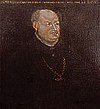
|
29 January 1478 Third son of William III and Margaret of Brunswick-Wolfenbüttel |
27 December 1484 – 24 January 1559 | County of Schleusingen | Anastasia of Brandenburg 7 or 16 February 1500 Neustadt an der Aisch eleven children |
24 January 1559 aged 80 | |
| Herman V[24] | 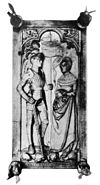
|
1470 Son of Frederick II and Elisabeth of Württemberg I |
9 June 1502 – 5 April 1535 | County of Hartenberg | Elisabeth of Brandenburg 23 October 1491 Aschaffenburg nine children |
5 April 1535 Schwarza aged 64-65 |
|
| Berthold IX[25] | 1493 First son of Herman V and Elisabeth of Brandenburg |
5 April 1535 – 1548 | County of Römhild | Anna of Mansfeld-Vorderort 17 August 1529 no children |
23 March 1549 Römhild aged 55-56 |
Children of Herman V, divided the county. Berthold sold his portion to the County of Mansfeld. | |
| Albert | 1495 Second son of Herman V and Elisabeth of Brandenburg |
5 April 1535 – 5 June 1549 | County of Schwarza | Catherine of Stolberg 1537 no children |
5 June 1549 Schwarza aged 53-54 | ||
| In 1549 Römhild was sold to the County of Mansfeld, and in 1555 it was sold again to the Electorate of Saxony | |||||||
| Catherine of Stolberg | 6 November 1511 Stolberg Daughter of Bodo III, Count of Stolberg-Wernigerode and Anna of Eppstein-Königstein |
5 June 1549 – 18 June 1577 | County of Schwarza | Albert 1537 no children |
18 June 1577 Schwarza aged 65 |
Widow of Albert, inherited his portion of Henneberg and left it, in her will, to her own family. | |
| In 1577 Schwarza was annexed to the County of Stolberg | |||||||
| George Ernest | 
|
27 May 1511 Schleusingen First son of William IV and Anastasia of Brandenburg |
24 January 1559 – 27 December 1583 | County of Schleusingen | Elisabeth of Brunswick-Calenberg 19 August 1543 Münden one child Elisabeth of Württemberg II 31 May 1568 Stuttgart no children |
27 December 1583 Henneberg aged 72 |
Sons of William IV, co-ruled, and neither of them left descendants. After their death, the county was divided between the Electorate of Hesse and the Electorate of Saxony. |
| Poppo X[26] | 
|
20 September 1513 Second son of William IV and Anastasia of Brandenburg |
24 January 1559 – 4 March 1574 | Elisabeth of Brandenburg 30 May 1546 Münden no children Sophia of Brunswick-Lüneburg 22 June 1562 Schleusingen no children |
4 March 1574 Schleusingen aged 60 | ||
| In 1583 Schleusingen was divided between the Electorate of Hesse and the Electorate of Saxony | |||||||
Notable members of the Henneberg family

- Bertold von Henneberg-Römhild (1442 – December 21, 1504), Prince-elector and archbishop of Mainz, son of George, count of Henneberg-Römhild.
- Count Otto von Henneberg, known commonly as Otto von Botenlauben from 1206, probably born in 1177 in Henneberg, died in Reiterswiesen near Bad Kissingen before 1245, was a German minnesinger, crusader and founder of Frauenroth Abbey.
- Herman I, Count of Henneberg
- Catherine of Henneberg
- William II, Princely count of Henneberg-Schleusingen
- William III, Princely count of Henneberg-Schleusingen
- William IV, Princely count of Henneberg-Schleusingen
Castles
- Bertholdsburg Castle, Schleusingen
- Römhild Castle
Coat of arms
Coat of arms of the Henneberg

The original arms of the Counts of Henneberg was a plain eagle. It was shown on the seal of Count Poppo VI in 1185 and his sons Berthold II and Poppo VII in 1202. The latter also used another coat of arms, first appearing around 1212, displaying a shield Parted per fess, above a double-headed eagle wings displayed and expanded, below chequy in three horizontal rows. The addition of the chequy may refer to the walls of Castle Botenlauben. A later depiction of the same arms, in the Weingarten Manuscript, depicting Count Otto of Bottenloube, adds the tintures; Parted per fess, above Or a double-headed eagle sable displayed and expanded, below chequy in gules and silver in five horizontal rows. This coat of arms continued to be used until at least 1280.[27]
A new coat of arms seems to have been introduced by Poppo VII and first appears in 1237, and depicts the more familiar arms of a Hen standing on a mountain, where the hen and the mountain (Berg) are canting arms for the name Henneberg.[27]
Coats of arms incorporating Henneberg
See also
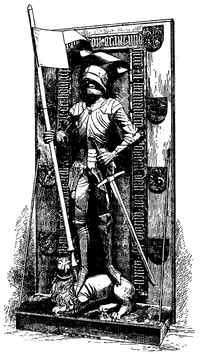
- Bishopric of Würzburg
- Vessra Abbey
- Aura Abbey
- Römhild
- Sondheim vor der Rhön
- Münnerstadt
- Irmelshausen
- Bad Kissingen (district)
- Poppo
- William II, German Emperor/Scraps
- Schmalkalden-Meiningen
- Wartburgkreis
- Hildburghausen (district)
- List of states in the Holy Roman Empire (H)
References
- ^ Irmelshausen separated from Lichtenberg in 1167, was annexed to Botenlauben/Hildenburg, and then sold to Coburg in 1251
- ^ Botenlauben was sold to the Diocese of Wurzburg in 1234; Hildenburg was sold in 1251.
- ^ After the sell of Aschach in 1390, the seat of the branch was changed again to Hartenberg.
- ^ Despite ascending first than Poppo V, Poppo VI was younger than him. That may be the reason he is numbered higher.
- ^ Despite ascending later than Poppo VI, Poppo V was older than him. That may be the reason he is numbered lower. Also, from this point on, the rulers of Frankenstein and Lichtenberg have a separate counting from the rest of the Henneberg lands.
- ^ The rulers' counting includes Henry I of Irmelshausen. Alternatively counted Henry III.
- ^ Alternatively counted Henry IV.
- ^ Alternatively counted Berthold V. The birth numbering includes Berthold, Bishop of Wurzburg, full brother of Henry III/IV.
- ^ Alternatively counted Berthold VII.
- ^ a b c d e f Detlev Schwennicke: Europäische Stammtafeln, Neue Folge, Band XVI., Tafel 146, Verlag: Vittorio Klostermann, Frankfurt a. M. 1995, ISBN 3-465-02741-8
- ^ Alternatively counted Henry VI.
- ^ Alternatively counted Henry III.
- ^ Alternatively counted Poppo X.
- ^ Alternatively counted Henry VIII.
- ^ Alternatively counted Berthold X.
- ^ Alternatively counted Herman V.
- ^ Alternatively counted Henry X.
- ^ Alternatively counted Berthold XII.
- ^ Alternatively counted William II.
- ^ Alternatively counted William III.
- ^ Alternatively counted Henry XI.
- ^ Alternatively counted William IV.
- ^ Alternatively counted William VI.
- ^ Alternatively counted Herman VIII.
- ^ Alternatively counted Berthold XVI.
- ^ Alternatively counted Poppo XII.
- ^ a b c Seyler, Gustav Adelbert (1909). Wappen der deutschen Souveraine und Lande. pp. 121–122, 388, 396.
- Schwennicke, Detlev. Europäische Stammtafeln: Stammtafeln zur Geschichte der Europäischen Staaten, Neue Folge. [European Family Trees: Family Trees for the History of European States, New Series.] BAND II, Tafel 10:Die Robertiner I und die Anfänge des Hauses Capet, 922-923 König der Westfranken, Marburg, Verlag von J.A. Stargardt (1984)
- Historische Landkarte: Grafschaft Henneberg 1755 mit den Ämtern Schleusingen, Suhl, Kühndorf mit Bennshausen, Reprint 2003, Verlag Rockstuhl, ISBN 3-936030-15-4
- Johannes Mötsch: Regesten des Archivs der Grafen von Henneberg-Römhild. Volumes 1 und 2. Böhlau, Köln etc. 2006, ISBN 978-3-412-35905-8
External links
 Media related to House of Henneberg at Wikimedia Commons
Media related to House of Henneberg at Wikimedia Commons- Henneberg Genealogy
- (in German) Direct male descent of Babenberger from Robertiner (Capet) family, in the German Wikipedia
- (in German) Early Babenberger genealogy, in the German Wikipedia







